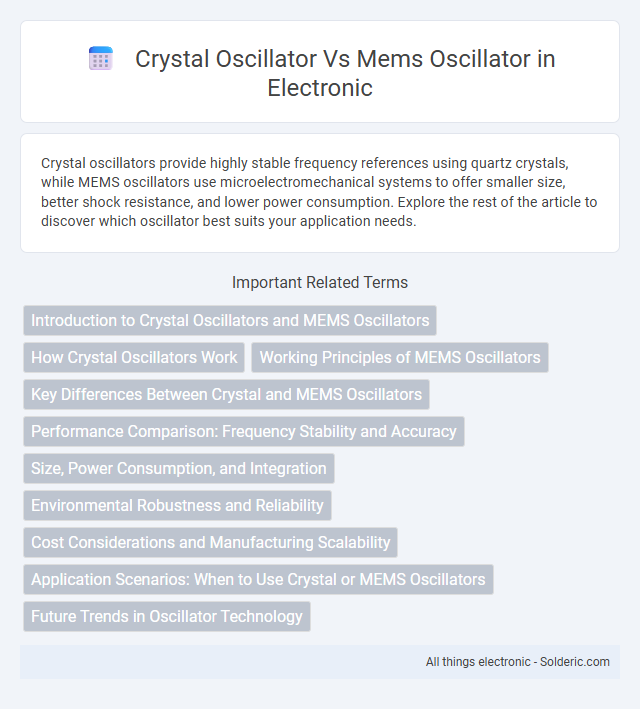Crystal oscillators provide highly stable frequency references using quartz crystals, while MEMS oscillators use microelectromechanical systems to offer smaller size, better shock resistance, and lower power consumption. Explore the rest of the article to discover which oscillator best suits your application needs.
Comparison Table
| Feature | Crystal Oscillator | MEMS Oscillator |
|---|---|---|
| Technology | Quartz crystal resonator | Micro-Electro-Mechanical Systems (MEMS) |
| Size | Larger footprint | Smaller, compact size |
| Frequency Stability | High stability (+-10 ppm to +-1 ppm) | Moderate to high stability (+-50 ppm to +-1 ppm) |
| Shock Resistance | Low to moderate | High shock and vibration tolerance |
| Power Consumption | Higher | Lower power consumption |
| Operating Temperature Range | -40degC to +85degC (standard) | -40degC to +105degC (wide range) |
| Startup Time | Longer startup time (ms to seconds) | Fast startup time (microseconds) |
| Cost | Generally lower cost for standard units | Often higher cost, decreasing with volume |
| Applications | Consumer electronics, communication, timing reference | Automotive, aerospace, IoT, harsh environment devices |
Introduction to Crystal Oscillators and MEMS Oscillators
Crystal oscillators use a quartz crystal's piezoelectric properties to generate stable frequency signals with high precision, commonly employed in clocks, radios, and communication systems. MEMS oscillators rely on microelectromechanical systems technology, offering miniaturized, robust, and temperature-resistant frequency control ideal for modern electronics and IoT devices. Both oscillator types serve as frequency references but differ in size, durability, and environmental resilience, influencing their application in various industries.
How Crystal Oscillators Work
Crystal oscillators generate precise frequency signals by exploiting the piezoelectric effect in quartz crystals, which vibrate at a stable resonant frequency when an electric field is applied. The quartz crystal's mechanical resonance creates an oscillating electrical signal, maintaining frequency stability and low phase noise. This inherent crystal vibration ensures highly accurate timing in applications like clocks, radios, and microprocessors.
Working Principles of MEMS Oscillators
MEMS oscillators operate using miniature mechanical resonators fabricated from silicon, which vibrate at precise frequencies when electrical signals are applied, generating stable oscillation. Unlike crystal oscillators that utilize quartz crystal resonance, MEMS devices leverage micro-electromechanical systems technology, offering enhanced robustness against environmental factors such as shock and temperature variations. This technology enables MEMS oscillators to provide reliable frequency references with lower power consumption and improved integration potential in compact electronic systems.
Key Differences Between Crystal and MEMS Oscillators
Crystal oscillators rely on quartz crystals for frequency stability, offering precise and low phase noise performance commonly used in communication and timing applications. MEMS oscillators utilize microelectromechanical systems technology, providing higher shock resistance, smaller size, and better temperature stability in harsh environments. Key differences include quartz crystals' susceptibility to mechanical stress versus MEMS oscillators' robust design, with MEMS often delivering faster startup times and lower power consumption.
Performance Comparison: Frequency Stability and Accuracy
Crystal oscillators offer exceptional frequency stability and accuracy due to their well-established quartz resonators, typically achieving stability within +-10 parts per million (ppm). MEMS oscillators leverage microelectromechanical systems technology, providing competitive stability with advantages in shock and vibration resistance, often maintaining accuracy around +-25 ppm under varying environmental conditions. Frequency stability in crystal oscillators may degrade over time due to aging, while MEMS oscillators tend to demonstrate superior long-term reliability and resistance to environmental factors, making them suitable for applications requiring robust performance.
Size, Power Consumption, and Integration
MEMS oscillators offer significantly smaller size compared to traditional crystal oscillators, enabling more compact device designs and improved integration on PCBs. Power consumption in MEMS oscillators tends to be lower, which enhances battery life in portable electronics and reduces energy costs in large-scale deployments. Your choice between these oscillators should consider MEMS technology for its ease of integration with CMOS processes and suitability for modern miniaturized and low-power applications.
Environmental Robustness and Reliability
MEMS oscillators demonstrate superior environmental robustness compared to crystal oscillators due to their resistance to shock, vibration, and temperature variations, ensuring consistent performance in harsh conditions. Unlike quartz crystals, MEMS devices are less susceptible to aging and contamination, resulting in enhanced long-term reliability and stability. These characteristics make MEMS oscillators ideal for applications requiring stringent durability and operational consistency across diverse environments.
Cost Considerations and Manufacturing Scalability
MEMS oscillators offer lower manufacturing costs and enhanced scalability due to CMOS-compatible processes and wafer-level fabrication, enabling high-volume production with consistent quality. Crystal oscillators, while providing excellent frequency stability, involve more complex and time-consuming processes, resulting in higher unit costs and limited scalability for large-scale manufacturing. The choice between MEMS and crystal oscillators depends on balancing cost efficiency with performance requirements in specific applications.
Application Scenarios: When to Use Crystal or MEMS Oscillators
Crystal oscillators are ideal for applications requiring high frequency stability and low phase noise, such as in telecommunications, GPS devices, and precision measurement instruments. MEMS oscillators excel in harsh environments with mechanical shock, vibration, and temperature extremes, and are commonly used in wearable devices, automotive electronics, and portable consumer products. Selecting between crystal and MEMS oscillators depends on factors like size constraints, environmental durability, and long-term reliability requirements.
Future Trends in Oscillator Technology
Future trends in oscillator technology emphasize MEMS oscillators due to their enhanced durability, smaller size, and lower power consumption compared to traditional crystal oscillators. Advances in semiconductor fabrication enable MEMS devices to offer improved frequency stability and integration with IoT and 5G applications. Research continues to target extending the temperature range and reducing phase noise in MEMS oscillators, positioning them as the preferred choice for next-generation timing solutions.
crystal oscillator vs mems oscillator Infographic

 solderic.com
solderic.com